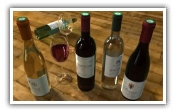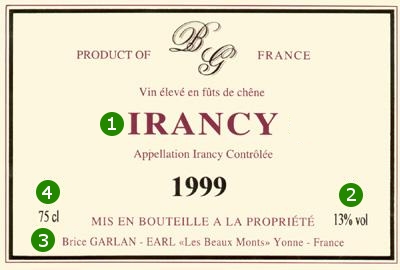Wine labels and information related to the CRD cap

Introduction
Labels are to wine what dialogs are to a movie. You can look at, smell and taste wine, but wine must also be understood. The label must allow identification of a wine and its legal representative. This is the one who bottled the wine, and his name must be mentioned on the label. Each origin is submitted to strict regulation and must inform the consumer on the following wine category belonging:
- Named Controlled Origin (AOC)
- Named Origin Wine Delimited of Higher Quality
- Local wine
Mandatory information

1 - Naming or area of production
The naming must be followed by the specification "XXX Controlled origin". The mention must refer to a vintage name, a place (in Burgundy said "climate") or type of wine (Alsace).
2 - Alcohol content
This information has been mandatory since Mai 1st, 1988.
3 - Name of the bottler and company
The bottler and his corporate address must be mentioned. It is also mandatory to specify the originating country
when the wine is to be exported. One can also add the mention "Produit de France", "Product of France", or "Produce of France".
This states that the wine has been bottled on the property, or in the region of production, by the wine maker or the trader
and under his responsibility.
4 - Volume
The specification of the volume can be followed by an "e" symbol specifying that all necessary controls have been performed to guaranty that volume.
5 - Special Ingrédients
Ingredients and other compounds responsible for allergy and other food intolerance must be mentioned on the label. This has been mandatory since November 25th, 2005.
Optional information
Mention "Grand vin"
It is forbidden alone but must be followed by the most generic Named Controlled origin to which the wine can pretend, depending on its producing circumstances.
Pictural representation
The exact or stylised representation of the Chateau, the domain, the brand or the logo is not mandatory. Not all chateaux do have one.
Name
The name of the chateau, the vintage, the domain or the brand is not mandatory. Generic wines would not have a name.
Vintage
Before 2005, a wine had to be totally produced from grapes from the specified year. Nowadays, a European Union directive specifies that 85% of grapes must be coming from the year displayed on the label.
Classifications and Prizes
Prizes attributed to a Year by an official organism are not mandatory. The year the prize was attributed must always be
greater than the year of the wine.
Mention of an official category (�cru class� or �cru bourgeois�) can be added.
Numbered bottles
A number can be given to bottles depending on production volumes.
Servicing Specifications
Indication relating to serving and conserving wine is allowed. Generally they are on a counter label.
Colour and Type
The colour and the type of the wine can be mentioned (i.e. dry white wine)
Caps

This cap is decorated by the Mariane seal and indicates that taxes have been paid to the DGDDI
(Customs and Indirect Rights General Direction). It allows distribution and sale.
The colour of the CRD cap (rights representative cap) allows the distinction of the level of naming for a wine.
- Green: Named Controlled origin and Named Origin Wine Delimited of Higher Quality
- Blue: Local and table wines
- Orange: Special wines (natural sweet wines and liquor wines)
- Yellow: Cognac or Armagnac brandies
- Grey: Other intermediary products



 Regions of France
Regions of France Regions of Spain
Regions of Spain Regions and areas from the world
Regions and areas from the world